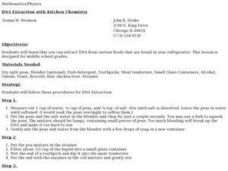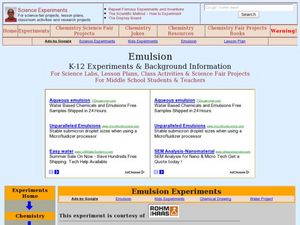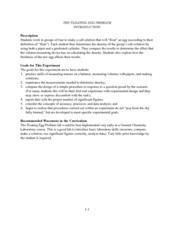Virginia Department of Education
Soap, Slime, and Creative Chromatography
Do you think chromatography paper suffers from separation anxiety? Young chemists make soap, slime, silly putty, and experiment with chromatography in this lesson. The material includes clear instructions for each experiment along with...
Curated OER
The Art of Soap Making
Here is a nice, clean wrap-up activity for your chemistry class when they are studying chemical reactions . They experiment with different oils to make soap. To make it more fun, they are to imagine that they are part of a soap testing...
Curated OER
Making Soap
Students explore what chemical indicators are and use pH paper to determine if something is alkaline or basic. In this pH lesson students manufacture their own soap.
Curated OER
What is Soap?
Students investigate soap, how it is made and its structure. In this soap lesson, students observe a demonstration of soap being made. Students observe the properties of soap and how soap performs in "real-life" situations like cutting...
Curated OER
Soap Bubble Chemistry
Students investigate soap bubbles. In this soap bubble chemistry lesson, students observe a demonstration using pop-it beads to represent a soap molecule. Students produce soap bubbles in the lab by making bubbles with a large bubble...
Curated OER
Fun With Chemical Changes
Looking for a terrific chemistry lesson for your 5th graders? This one could be for you! After a teacher-led demonstration, learners are broken up into groups and perform an experiment using cabbage juice, water, window cleaner, and...
Curated OER
Soap Smart, Healthy Fun
Seventh graders investigate the scientific methods of testing the effectiveness of soap use against germs. They study the history and chemistry of soap as it has helped control the spread of germs. They make bubble soap.
Curated OER
Testing Water for Hardness Using Soap Bubbles K-12 Experiments & Background Information
Students examine water and what causes it to become hard. In this water lesson students use the soap test and determine the mineral content and hardness of a sample of water.
Curated OER
Twirly Whirly Milk
Student observe the effect soap (or detergent) has on the movement of food color in milk. Pupils observe the properties of solids and liquids while making butter. They read a poem, Shaking, and listen for ryhming words. Studdents...
Curated OER
Molecular Forces at Work: Creating Soap Bubbles
Learners investigate adhesion, cohesion and surface tension. In this molecular forces lesson plan, students observe multiple demonstrations that show surface tension, the attraction of water molecules to each other and the ability of...
Curated OER
Crazy Chemistry Lesson Plan
Students study water molecules, cohesion and surface tension. In this molecule cohesion lesson students create chemical reactions that cause a balloon to inflate and another one that results in soap suds.
Curated OER
DNA Extraction with Kitchen Chemistry
Students extract DNA from green peas. In this DNA extraction lesson plan, students use a blender to chop up peas, they mix them with a little soap, they tenderize them and they mix them with alcohol to see the DNA precipitate through the...
Curated OER
The Chemistry of Bigger Bubbles
Fourth graders explore properties of bubbles. In this instructional activity about bubbles, 4th graders perform an experiment. Students analyze the properties of bubble making substances and surface tension. Students create a square...
Curated OER
Blow the Best Bubbles
Here is an exciting, and meaningful science lesson on the formation of bubbles! Young scientists have three cups with a variety of solutions in them. One cup has detergent only, one has glycerin added to it, and the third has corn syrup...
Curated OER
Emulsions
Students identify the characteristics and composition of emulsions. In this chemistry lesson, students classify household products according to emulsion type. They explain how to make the best emulsion.
Curated OER
Making soap you can use
Those textbook experiments are no good. Using this simple method you can make a real bar of soap. It's
Curated OER
Surface Tension (Soap Boat)
Students investigate the affect of soap and water temperature on surface tension.
Curated OER
Electrostatics
Students explore charges using balloons and soap bubbles. In this chemistry lesson plan, students analyze the Van de Graaf generator to see how charges flow using charged particles, static electricity and lighting. This assignment...
Curated OER
Candy Cane Chemistry
Fourth graders, in groups, examine the effect of heat on bonding forces by doing laboratory work.
University of Georgia
What's So Special about Bottled Drinking Water?
Is artesian water designed to be better, or is it just from wells similar to those in the city of Artesium? This experiment looks at many different types of bottled waters, including artesian. Using a soap mixture, scholars test to see...
Curated OER
The Floating Egg Problem
This is the grown-up version of the classic "float an egg in salt water" experience, plus an experiment in soap making. High schoolers explore density, but more importantly, practice accuracy, precision, and the use of significant...
Curated OER
Bubble and Boyle
Even middle schoolers still enjoy experimenting with bubbles! They execute a series of experiments enabling them to distinguish between convex and concave surfaces, explore the properties of buoyancy, surface tension, and density,...
Curated OER
Silica Tetrahedron Model
Very simply, pairs of learners construct a model of the tetrahedral silica structure using raisins and toothpicks. They dip it into a soapy solution and then blow a bubble "atom" into its center. The lesson plan gives instructions that...
Curated OER
WS 8.9 Presentation Questions
In this mixtures worksheet, students answer twenty three questions about student presentations on topics such as amalgams, homogenized milk, antifreeze and coolants, soaps and detergents and water softeners.

























